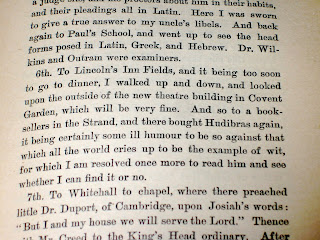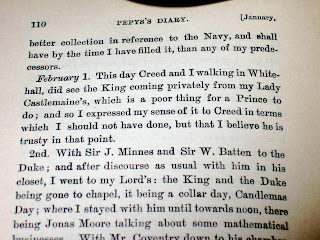

Perhaps it’s because I’m an identical twin, but I’ve always been drawn to books in sets.
Yesterday, my fiancée and I visited Grey Matter Books in Hadley, one of the region’s newest used bookstores. They had a number of sets for sale -- modern and antiquarian. I noticed also, however, a number of “broken” sets. In some cases the broken set was complete but for one missing volume; in other instances, only one volume of the set was present.
Typically I wouldn’t buy a broken set. Something about the incompleteness seems depressing to me. Nonetheless, I ended up buying a single volume from an eight-volume set; only the one volume was available. It was a good price, though, and the owner even knocked it down a bit for me. The set is a standard and essential reference tool for my field and I figure I can just add to it over time: if I serendipitously find the other volumes in the future as I browse bookstores, I’ll gradually complete the set. It will be useful, but filling in the gaps in a broken set in this way is never completely satisfying; a set of specific copies that were printed and then sold together as one unit seems to belong together perpetually. Even though they’re in stand-alone volumes, only together do they make up one whole book. The volumes in a set have a history together, like a family.

This week’s book is an orphan from a set of five volumes (actually “ten volumes in five”, according to the title page): volume one from The Diary of Samuel Pepys, With selections from his correspondence, and an introduction to each volume. The work is a modern-spelling edition prepared by Professor Henry Morley (1822-1894) and published by The Cassell Publishing Company of 31 East 17th Street (Union Square) in New York. There’s no date on the volume, but Morley only became a professor after 1865 and Cassell was only known as “The Cassell Publishing Company” after 1888. Dealers online vary from 1880 through 1900. The first edition (issued in ten separate volumes), however, was published by Cassell in 1887; the volumes of the first edition are in yellow boards and bear black printed decorations. This volume is from the second edition and is bound in dark blue cloth boards with faded gilt titling on the spine.

After the half-title and title page there appears Morley’s general introduction (pp. [5]-9) and the “Preface to the Original Edition” (pp. [11]-14), signed “Braybrooke” (that is, Richard Neville, Lord Braybrooke) and dated “Audley End, May 14, 1825”. The first two years of the diary (1660-1661) run from pp. 15-192. There then follows an internal title page for the next “volume” (covering 1662-1663) and the pagination re-starts. Morley’s introduction for the second half runs from pp. 5-8 [should be 3-6] and the diary runs from pp. 9-192 [should be 7-189]. The error in paginating the second half suggests that, in making the “two volumes in one”, the printer simply followed the set-up of the original ten volume version (in which the 1662-1663 volume begins with a half-title and title page, thus justifying the start of Morley’s introduction on p. 5 instead of p. 3).

There is no evidence of ownership or use, with the exception of four pencil underlines in Morley’s introduction to the second half. The printing was generally well executed, though a few errors slipped in, including a missing possessive apostrophe in the running title on p. 47 of the first half and the slippage of type at the end of a line on p. 169 of the second half. The book was machine-printed and may be expressed collationally as 12o: [#1] [“A-33”16] - “F-33”16 [“A-41”15] - “F-41”16 [π2]: $1. The paper is a sturdy stock that took the bite of the type fairly well but is beginning to discolor a bit with age; there are no watermarks, but there are 3cm horizontal chain-lines. The pages measure 11cm x 16.5cm. Overall, with the exception of a slightly splitting spine (internally) and some of the usual bumps to the boards, it is in good condition: no tears, no folds or bends, and no pronounced staining or foxing.

Samuel Pepys (1633-1703; above) is sometimes referred to as the first “blogger”, but there is a crucial difference: Pepys’s diary was intensely personal and private. In order to keep prying eyes from reading it, he went so far as to write the entire document in a shorthand of his own invention. The details it contains are often scandalous, embarrassing, and even potentially politically dangerous. Today’s bloggers often include such content in their own writing, of course, but with the point of stirring up trouble. Pepys was writing for himself; bloggers (trust me) write for everyone else. Pepys was a minor official of Restoration England; in 1672, after years of service in the Admiralty, he was appointed secretary of that department, and in 1684 he was made president of the Royal Society. But he is today best known for his remarkable diary; spanning the years 1660 (the year Charles II was restored to the throne of England) up to 1669, Pepys’s diary gives an almost daily glimpse into the world of Restoration London.

From domestic politics to social affairs, from local gossip to global commerce, from personal habits to international diplomacy, from literary trends to theatre news, Pepys offers modern readers access into a world that is remarkably familiar but at the same time intensely foreign. Following the publication of the first “translation” of the manuscript (Braybrooke’s in 1825), the diary has remained a staple item of literary studies and history through over 250 modern editions and at least one movie version.

As I mentioned, having an orphaned volume always generates a sense of incompleteness. Flipping through the pages of my one volume from the Pepys diary, however, and following the numerous day-to-day threads he weaves through his record, I feel a particularly strong disconnect when I reach the final page -- as if reading only the first four years of the diary and then suddenly coming to an unresolved halt at the end of 1663 not only cuts my reading experience off, but actually preternaturally shortens Pepys's life itself.



No comments:
Post a Comment